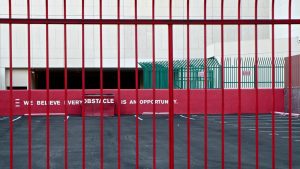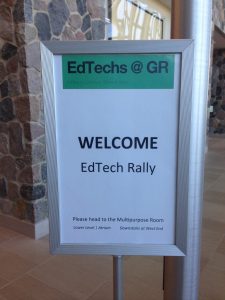
“Design is thinking made visual” by Yeray Vega is licensed under CC BY-NC-ND 4.0
This weeks themes have been critical thinking, problem solving, decision making and design thinking. As a high school math and science teacher, I spend significant time discussing how to identify valid information and trustworthy resources. Each semester I begin with several lessons that define, model and teach higher level thinking, critical thinking, and problem solving and these themes permeate all my classes. As such, I will focus my energies this week on the less familiar concept of design thinking.
The Interaction Design Foundation defines design thinking as:
a non-linear, iterative process which seeks to understand users, challenge assumptions, redefine problems and create innovative solutions to prototype and test. The method consists of 5 phases—Empathize, Define, Ideate, Prototype and Test and is most useful when you want to tackle problems that are ill-defined or unknown.
The 5 phases of design thinking (as outlined by the Interaction Design Foundation) really require learners to be well rounded and sophisticated thinkers. Let’s break it down:
- Empathize: See a need, fill a need. This requires that the design thinker understand others and has a high level of emotional intelligence.
- Define: Although defining is usually considered first level thinking, here the design thinker must gather the data collected through empathizing and then analyze and synthesize that information to define a problem to be solved. This process requires that design thinkers are skilled and experienced higher level thinkers.
- Ideate: The true test of the higher level thinker! One must think outside the box to create innovative solutions.
- Prototype: Start to create solutions. Left brain thinkers, prepare to challenge your abilities and strengthen your right brain’s creative and artistic capabilities.
- Test: Try your solutions out
It follows that digital tools used with the intention of design thinking and learning should promote critical and higher level thinking because of the very nature of the process. Critical thinking (the objective analysis and evaluation of an issue in order to form a judgment) is a necessary skill required for design thinking.
Although I really like lists and step by step instructions, Stephanie Overby warns in an article published in The Enterprisers Project that we should not attempt design thinking as a process, but rather as a mindset geared towards creating and providing a service. She describes the major tenets of design thinking as observation, empathy, human need, and ongoing engagement. Another interesting read, also by Stephanie Overby, is 10 Design Thinking Myths Debunked.
Stephanie Overby suggests the following 5 Ted Talks for describing the intentions, process, and key characteristics of Design Thinking: (It is important to note that I am watching these Ted Talks though the lens of an educator during the Covid 19 pandemic, and hence have a focus on being innovative when designing online learning opportunities for my students.)
Tony Fadell: The first secret of design is…noticing
Favorite Quote from Tony Fadell: “I try to see the world the way it really is. Not the way we think it is. Why? Because it’s easy to solve a problem that almost everyone sees, but its hard to solve a problem that almost no one sees.”
Tim Brown: Designers – Think Big!
Favorite Quote from Tim Brown: “In times of change we need new alternatives, new ideas…and in these times of change we need these new choices because our existing solutions are simply becoming obsolete.” I especially like Tim Brown’s 4 characteristics of design thinking:
- Design is human centered
- Design thinkers learn by making (prototyping)
- The primary objective is participation
- Design may have its greatest impact when its taken out of the hands of designers and put into the hands of everyone.
David Kelley: How to build your creative confidence
Take-away or provocation from David Kelley: How can we change the trepidation that teachers and students have towards online learning?
Paul Bennett: Design is in the details
Favorite Quote from Paul Bennett: “It’s not about huge, ridiculous things we need to do. It’s about tiny things that can make a huge amount of difference.” Also, I really like the term Paul Bennett uses: Empathic solution.
Guido Stompff: Speed up Innovation with Design Thinking
Favorite Quote from Guido Stompff: “Before, no one knows what the outcome will be. In the end they have something they’re quite proud of. But they learn on the go, they learn while they create what they are inventing.”
Since much of this week’s learning was done through watching Ted Talks, I decided to conclude with a recorded reflection using Zoom:
Additional Resources:
Buchanan, R. (1992). Wicked Problems in Design Thinking Design Issues: MIT Press, Vol. 8, No. 2 (Spring, 1992), pp. 5-21
Galileo (2019). Designing Learning. Retrieved from https://galileo.org/designing-learning/ (Inquiry and Design Thinking)


